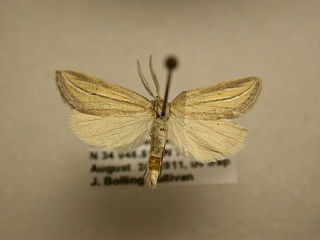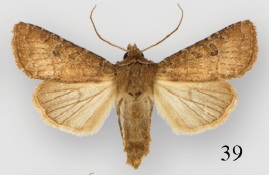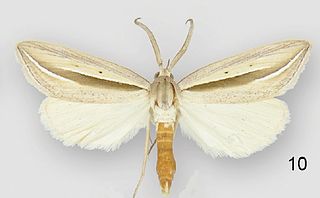
The Noctuidae, commonly known as owlet moths, cutworms or armyworms, are a family of moths. They are considered the most controversial family in the superfamily Noctuoidea because many of the clades are constantly changing, along with the other families of the Noctuoidea. It was considered the largest family in Lepidoptera for a long time, but after regrouping Lymantriinae, Catocalinae and Calpinae within the family Erebidae, the latter holds this title now. Currently, Noctuidae is the second largest family in Noctuoidea, with about 1,089 genera and 11,772 species. This classification is still contingent, as more changes continue to appear between Noctuidae and Erebidae.

Doryodes is a genus of moths in the family Erebidae.

Autographa sansoni, the Alberta beauty, is a moth of the family Noctuidae. The species was first described by F. H. Wolley Dod in 1910. It is found in the western mountains of North America, from Alaska south to Oregon, Idaho and Arizona. Occurring mainly in the Pacific Northwest, it thrives in mid-to-high elevation conifer forest habitat, as well as some areas of coastal rain forest in the Coast range. However, it is also found in a non-contiguous range in sub-alpine forest in the Rocky Mountains, ranging from Alberta in the north, to New Mexico in the south. The wingspan of an adult ranges between 34 and 36 mm. It is widespread, and a relatively common species.

Doryodes bistrialis, the double-lined doryodes moth, is a moth of the family Erebidae. The species was first described by Carl Geyer in 1832. It is found in the eastern United States, including Delaware, Virginia, Mississippi and Florida. Its habitat consists of wet pine flatwoods and pine savannas.

Lascoria ambigualis, the ambiguous moth, is a litter moth of the family Erebidae. The species was first described by Francis Walker in 1866. Adults are on wing from April to September. There are two generations in Connecticut and multiple broods in Missouri.

Argyrostrotis sylvarum, the woodland chocolate moth or brown wavy line argyrostrotis, is a moth of the family Noctuidae. The species was first described by Achille Guenée in 1852. It is found in the US from Virginia south to Florida and Texas.
Apantesis bowmani is a moth of the family Erebidae. It was described by Douglas C. Ferguson and B. Christian Schmidt in 2007. It is found in the United States in western Colorado and southeastern Utah. It occurs at elevations between 1,520 and 2,130 meters.
Apantesis fergusoni is a moth of the family Erebidae. It was described by Schmidt in 2009. It is found in the central Sierra Nevada and White Mountains of California. The habitat consists of subalpine and alpine areas.
Apantesis margo is a moth of the family Erebidae. It was described by Schmidt in 2009. It is found in grassland and transitional habitats on the northern Great Plains and Southern Rocky Mountain Front ranges, south to east-central Arizona.

Apantesis phyllira, the phyllira tiger moth, is a moth of the family Erebidae. It was described by Dru Drury in 1773. It is found in North America from Quebec and New England south to Florida and west to Texas, Colorado and Alberta. The habitat consists of dry, open woodland and grassland. The species is listed as endangered in Connecticut.
Apantesis ursina is a moth of the family Erebidae. It was described by Schmidt in 2009. It is found on the Channel Islands off the coast of southern California and in mainland south-western California from Kern County south to San Diego County. It is probably also present in Baja California.

Protorthodes ustulata is a moth in the family Noctuidae first described by J. Donald Lafontaine, J. Bruce Walsh and Clifford D. Ferris in 2014. It is found in North America from south-eastern Wyoming southward to the Guadalupe Mountains in western Texas and westward to central and south-eastern Arizona and northern Mexico.

Doryodes insularia is a moth of the family Erebidae first described by George Hampson in 1904. It is found on the Bahamas.

Doryodes spadaria, the dull doryodes moth, is a moth of the family Erebidae. The species was first described by Achille Guenée in 1857. It is found in North America, where it has been recorded from coastal Florida, Georgia, North Carolina, South Carolina and Texas. The habitat consists of salt marshes.

Doryodes desoto is a moth of the family Erebidae first described by J. Donald Lafontaine and James Bolling Sullivan in 2015. It is found along the Gulf Coast of the US state of Florida between Sarasota County and Gulf County. The habitat consists of coastal salt marshes.

Doryodes okaloosa is a moth of the family Erebidae first described by J. Donald Lafontaine and James Bolling Sullivan in 2015. It is found in the US in Okaloosa County, Florida and likely ranges south in the coastal brackish marshes toward the St. Petersburg/Tampa area and to the west along the Florida coast.

Doryodes fusselli is a moth of the family Erebidae first described by J. Donald Lafontaine and James Bolling Sullivan in 2015. It is found in the US state of North Carolina, occurring from Dare County in the north to Brunswick and New Hanover counties in the south.

Doryodes latistriga is a moth of the family Erebidae first described by J. Donald Lafontaine and James Bolling Sullivan in 2015. It is found in the United States in tidal creeks and salt marshes from Alabama to Louisiana.

Doryodes reineckei is a moth of the family Erebidae first described by J. Donald Lafontaine and James Bolling Sullivan in 2015. It is found along the US Gulf Coast in the western panhandle of Florida along to eastern Texas. The habitat consists of Spartina marshes.
Hadena plumasata is a species of cutworm or dart moth in the family Noctuidae. It is found in North America, particularly in California along the eastern slope of the Sierra Nevada, including the species' namesake, Plumas County.















